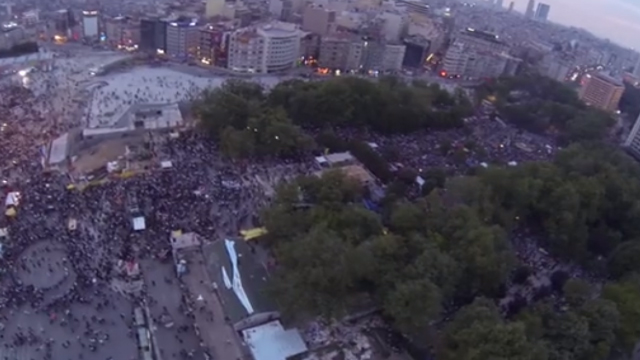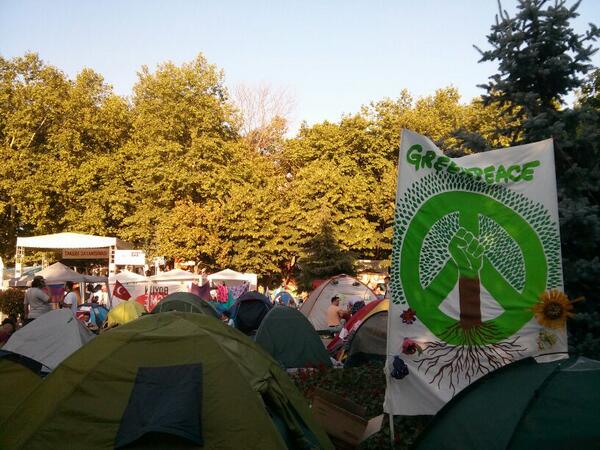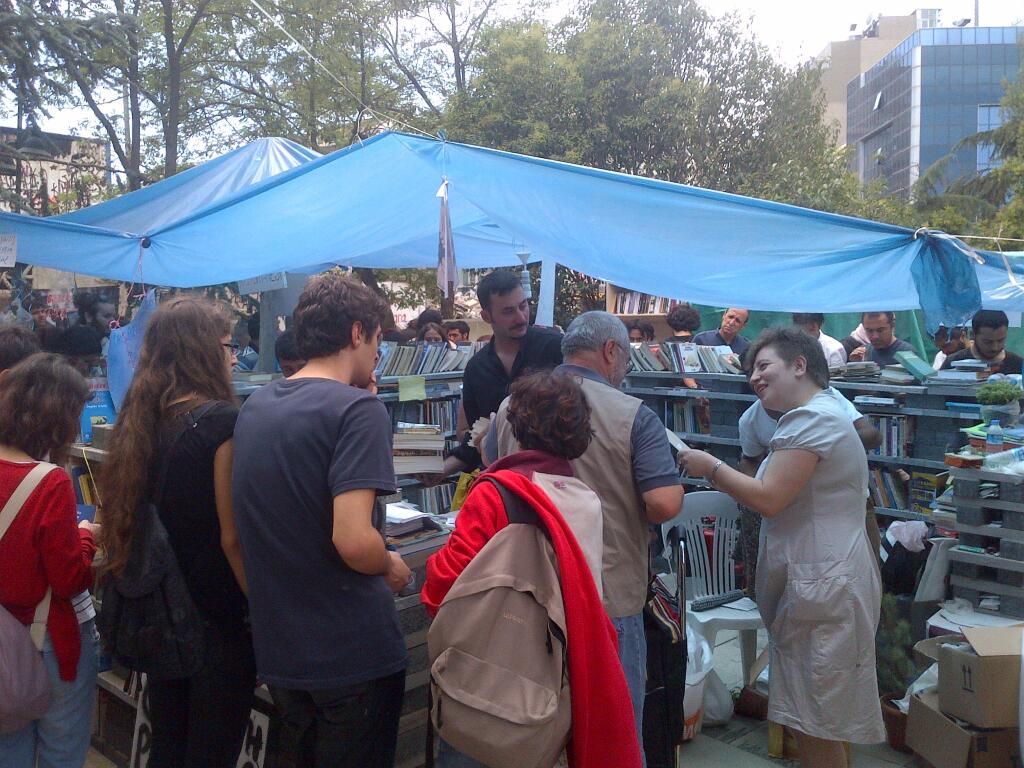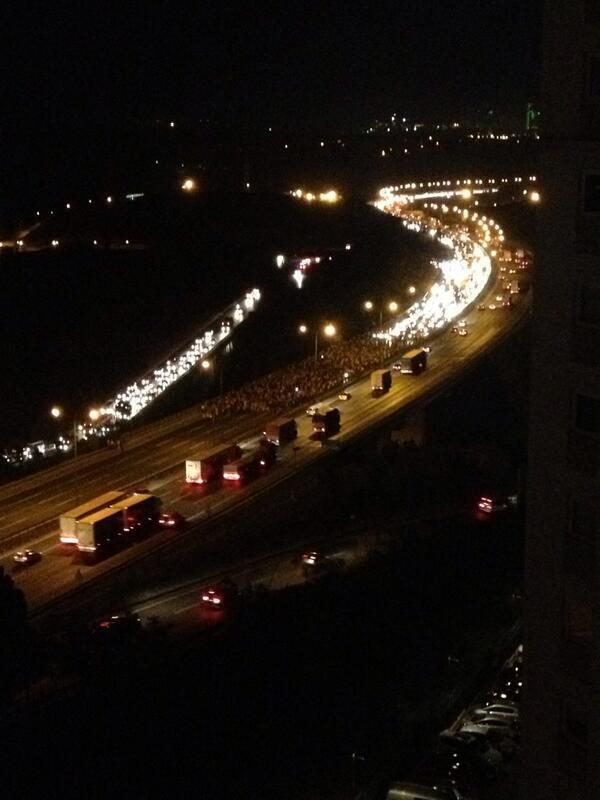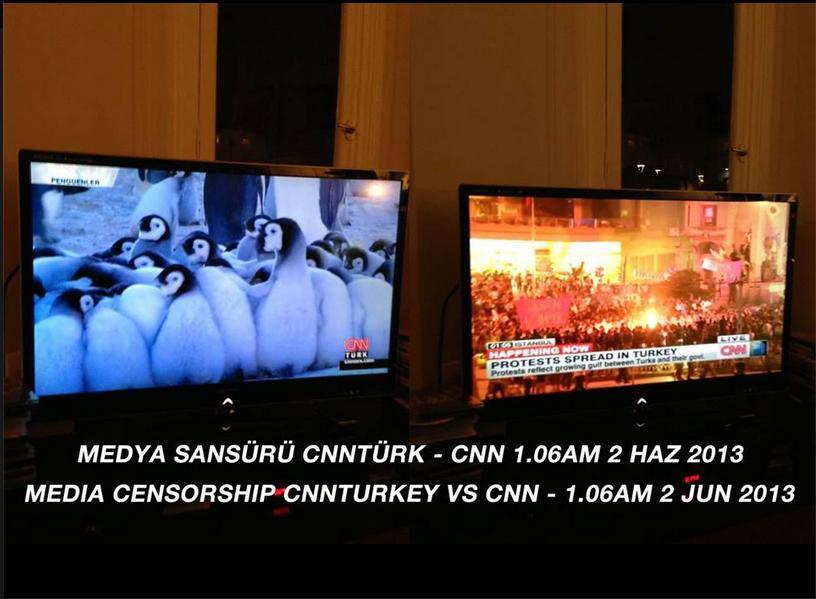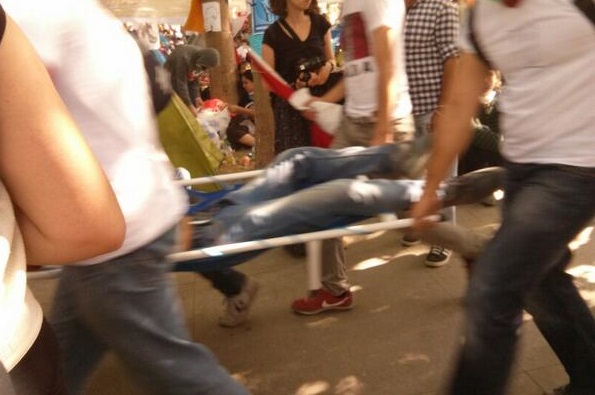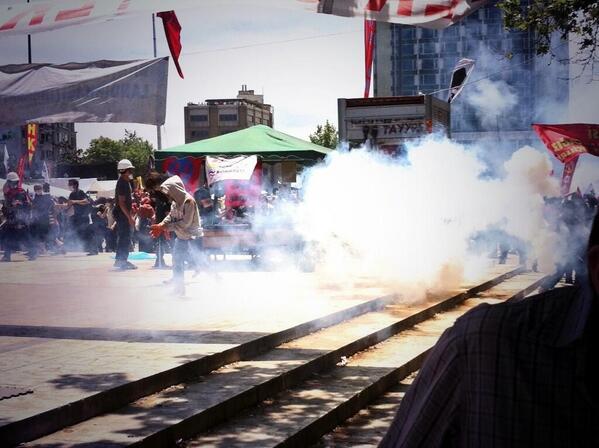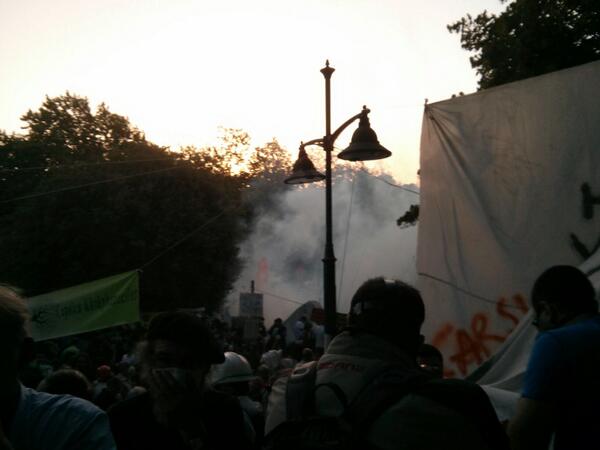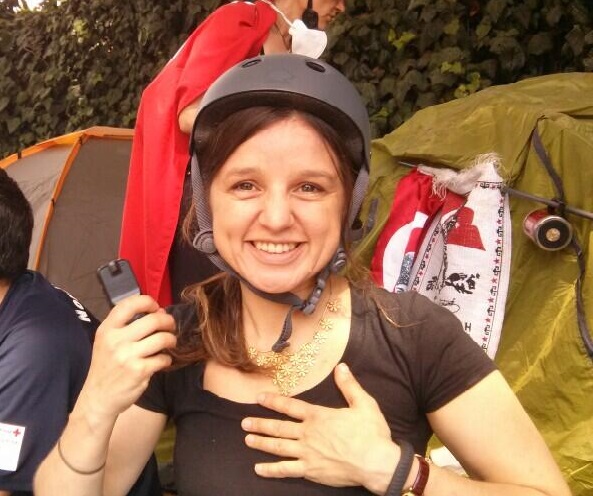What do #occupygezi Protesters Want? My Observations from Gezi Park
technosociology 2013-06-12
I have spent the last few days interviewing people in Istanbul’s Gezi Park protests as well as hanging out in the park, observing, chatting informally with everyone ranging from journalists to visitors to the park and occasionally getting massively tear gassed. My lungs continue to burn as I type this morning.
For context, let me first explain that most everything you have been seen on TV has been from the Taksim square where the most of the clashes are occurring between the police. Those are mostly groups that are not necessarily part of the Gezi Park protests in the beginning, but have moved to the area as part of the developments. You are getting the wrong impression from TV feeds focused solely on Taksim Square. That is not the Gezi Park protest I have been observing.
Here’s an aerial view of the area.
The park on the right is a tent city, and that’s where the protest is taking place. It all started when the government announced it was going to tear down this area and build a replica of an Ottoman army barracks with a shopping mall potentially integrated into it. It’s one of the last few remaining green areas in the popular Taksim neighborhood. The small group of protesters were attacked 5am in the morning, their tents burnt down and trees started being uprooted. The news spread via social media, especially Twitter and social books, as well as SMS and phone calls, and people started congregating in the area in response. After massive clashes for about a day, the police withdrew and the area grew into a large tent city and a protest. (The police and the clashes returned yesterday). For most of my time there, it was a festival like space.
This is what the inside of the park lookseed like before the police attack last night:
There are libraries (since destroyed by the police), food center, restrooms, theater, and lots of formal and informal activities within the park. It’s a lively, peaceful and colorful space. Here’s the library before:
Well, here’s what the library looks like now:
During yesterday’s clashes, thhere were indeed a few people who threw molotov coctails to the police in the square –which you may have seen on TV because that is the kind of visual that television stations like to put on a loop– but in my obsevrations, the Gezi park protesters are very alien to that kind of behavior. In fact, during those clashes they tried to form a human chain around the park and stop such violence from happening. They made calls via their megaphones for it to stop. I have walked most every inch of the park and spoke to a wide range of people. The protesters I spoke with expressed strong commitment to non-violence.
Here’s the human chain attempt to stop the clashes between police and the molotov throwers (who were about six people) and to protect the park. The chain was dispersed with gas and water canons:
In fact, even the slightest scuffle is in the park calmed down immediately. I observed this first-hand when a visiting youngster, about 14 or 15, tried to pick a fight with an older man claiming that he had looked at his girlfriend the wrong way. Dozens of people immediately intervened, calmed the youngster, took him away, helped his girlfriend, asked her if she was okay, and generally made sure it was all calm again. “Not here, no fighting, not here” was heard.
There is also a campaign within the park, with many signs, asking people not to consume alcohol –yes, I know it’s ironic as government’s attempts to legislate lifestyle issues such as alcohol consumption are part of people’s grievances. However, people I talk to say that it’s very important that they keep the park clean, well-behaved, cooperative and non-violent. Signs everywhere say that “nothing is for sale in the park.” Food, masks, medical and other supplies, clothes, etc. are distributed free of charge. (There is also a burgeoning “street peddler” ring in the perimeter areas of the park, selling helmets, masks and, happily for me, fresh simit–Turkish sesame bagels.)
After talking to the park protesters for days here is a very quick compilation of the main complaints and reasons people say brought them to the park:
1- Protesters say that they are worried about Erdogan’s growing authoritarian style of governance. “He thinks we don’t count.” “He never listens to anyone else.” “Why are they trying to pass laws about how I live? What’s it to him?”
Erdogan’s AKP party won the last election (its third) and is admittedly popular with many sectors of society, including some who are now in the Park have voted for him. It has accomplished many good things for the country through a program of reform and development. Any comparisons with Mubarak and pre-Tahrir 2011 Egypt are misplaced and ignorant. The country is polarized; it is not ruled by an unelected autocrat.
However, due to the electoral system which punishes small parties (with a 10% barrier for entrance to the parliament) and a spectacularly incompetent opposition, AKP has almost two-thirds of the deputies in the parliament with about 50% of the vote. Due to this set up, they can pass almost any law they want. People said to me “he rules like he has 90%.”
So, that seems to be the heart of the issue. People have a variety of grievances, but concentrate mostly about overreach and “majoritarian authoritarianism.” For example, Erdogan recently announced that they would be building a third bridge over the Bosphorus strait. Many people felt that the plan was not discussed at all with the public and concerns about environmental impact ignored. Then, he announced that they had decided the bridge would be named “Yavuz Sultan Selim”–an Ottoman king (“padisah”) famous for a massacre of Alevi (Turkey’s alawites) populations. Unsurprisingly, Alevis who compromise a significant portion of the Turkish population were gravely offended. In the predominantly “GAzi” (not Gezi) neighborhood, people have been marching every night since the Taksim protests began. Last night, they blocked the main TEM highway for a while before voluntarily dispersing.
I asked someone from the Gazi neighborhood (GAzi neighborhood is not GEzi park.) why they were so angry and why there were protests there every night. “Wasn’t there anyone else in all of Turkey’s history to honor with the name of that bridge?”the person said. “Doesn’t he have a single Alevi friend to ask? Why can’t they ever ask someone about anything before announcing their decision?”
During the protests, Erdogan called the protesters “riff-raff” (capulcu) which has now been adopted by the protesters–they jokingly call themselves the riff-raff party. They are offended but also decided that they will call just respond with humor. Such dismissive language, undoubtedly, helps polarize the situation. “Why can’t he let us even have one little park?” was a common refrain among the people I interviewed. “Why must everything be his way?”
2- A very common and widespread complaint is about censorship. It is, indeed, much worse than I had thought. I had already blogged about how the CNN Turkey was showing penguin documentaries while the protests were ongoing.
In the square, I chatted with journalists and people who told me they were journalists but joining the protests after their shift ended. They told me, some in tears, that they are not free. They said that the stories they file are shelved. One told me of being told “why don’t you rewrite this column” after writing a sharp critique of Erdogan’s stance during Arab Spring versus now.
I watched last night as the governor of Istanbul was “interviewed” on television on CNN Turkey (it’s not the worst or only awful one, but it’s notable.) There were ongoing clashes all day, in the middle of the biggest city in Turkey. The governor had said in the morning that the park would not be attacked. I was in the park all day and was tear gassed on and off all day–this was thoroughly documented. (I left when things got much worse and I couldn’t breathe, or obviously do interviews anymore. I’m there to interview, not to be tear gassed beyond rhyme or reason).
Instead of asking him tough questions, or even things that could be considered any kind of questions, the “interviewer” lobbed phrases that were so non-questions that “softball” would be a compliment. The “interview” ended with the “interviewer” asking the governor that perhaps they should end by having him repeat his call to parents. Oh, yes, the governor said. That’s a good note. “Parents should tell their children not to be in the park anymore. It’s not safe.”
Also, the few channels who were broadcasting the protests live were just hit by large fines by Turkey’s regulatory agency for “inciting people to violence.” The level of control over the public sphere via media is worse that I had thought, and I was already worried. The journalists I spoke with said to me that it’s not just intimidation by government–many media publishers are also large conglomerates and want to keep good relations with the government for their business interests.
Unsurprisingly, social media, especially Twitter and Facebook have emerged as key protest and information conduits. Turkey also has no equivalent to “Al Jazeera” which played a major role during the Arab Spring. Most protesters I talked with said that this just wouldn’t be possible without especially Twitter and Facebook. Most people heard of what was going on in the park during the initial police attack (when the protest was small, the police moved in, burned the tents and started cutting down the trees) via Twitter and Facebook and showed up to try to protect the park. They couldn’t have heard it on mass media because it was broadcasting anything but the news. Penguins have become a mock symbol of the protest.
3- The police actions are a common cause of complaint among the protesters. The use of tear gas is quick and massive. This is not the first protest that has been subjected to massive tear gas. In fact, it seems to have become a modus operandi and main style of policing of demonstrations. Yesterday, while I was in the park, tear gas volleys regularly landed in the park. My interview recordings are interrupted by “gas breaks” a bang, coughing. I watched people convulse and throw up from tear gas. I witnessed tear gas being thrown into the park when it was very crowded, creating a dangerous situation as people tried to run away and risked trampling. The park is experienced, though. As people panicked, lots of seemingly experienced protesters, started yelling for people to calm down, opening exits, helping people. One of the key demands of the protests is freedom as assembly and freedom from this kind of police intervention. Also, protesters were hit with tear gas canister–what had also happened in Egypt and killed many people.
I personally saw a young man bleeding from the head on a stretcher being rushed to the “field hospital” area–which also got attacked with tear later. After him, another man came sobbing through the area. “They are aiming the canisters at our head. Aren’t they human? Aren’t we human?” he sobbed.
Here’s a picture I took of person in stretcher–he was bleeding from his head, not captured in the photo:
Here are some pictures during the day when the tear gas was lobbed inside the park. I don’t have a picture for some of the worst clashes when the park was basically engulfed in massive amounts of gas partly because it was a difficult situation and also partly because some of the worst parts happened after I left. These pictures are from June 11th, when the governor said the park would not be attacked.
I did not take this picture but it shows you how it can get:
This one I took–one of the many tear gas volleys fired into the park while I was there on June 11th.
I personally think tear gas should be regulated internationally and be used only in truly and rarely dangerous situations. We need an arms control treaty on tear gas. Not only is it not non-lethal, it has become a way to deny freedom of assembly. I understand that there are some situations that the police forced do need to use non-lethal force. The situation, however, seems out of hand and instead of a high bar for use of this substance, it has become something that is just lobbed.
Some of this has been documented in my twitter feed (I can be found as @zeynep).
I know that now I am going to be criticized heavily by some people in Turkey. Let me end with some clarifications. I have friends who are and remain strong AKP supporters and they, too, are mostly aghast at what has been happening. I’ve always tried to explain that the government has popular support and remains popular, however in a polarized country.
Rumors of Internet shut-down are false. In fact, throughout the protests, I have been able to tweet, with pictures, from the park (some mobile operators brought extra repeater trucks to the area). I lost Internet only once–during the worst clashes– and I later learned that one of the repeater trucks was on fire, likely contributing to the problem as well as tens of thousands of people desperately trying to call out. However, I witnessed the ridiculous levels of media censorship first hand and I heard some stories directly from some journalists.
Some people asked my why I don’t go interview AKP supporters and their use of social media? In fact, I’d be happy to at some point. I study social movements and social media so it is natural for me to interview protesters. The notion that AKP supporters do not use social media is false. The idea that AKP is just behind the times with such technologies is also false. The prime minister did indeed call Twitter a menace (or curse) to society, but all his top lieutenants are on social media and very active. So is, as far as I can tell, large portions of AKP’s own public. AKP is a tech-savvy party full of competent people. There is simply no comparison to Mubarak’s inept misunderstanding of the new media ecology.
And that’s it for now. I am now going to go back to the battered, tired Gezi Park and continue doing interviews for as long as I can. I shouldn’t have to interview with a helmet, though, in fear of tear gas canister landing on my head. The governor keeps promising that the park won’t be attacked. Here’s me interviewing yesterday in the park, and here’s hoping to less tear gas.
Note: Hastily written, sorry for typos and lack of more links. To be corrected later.
